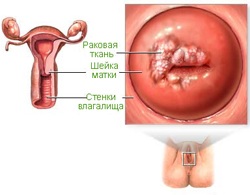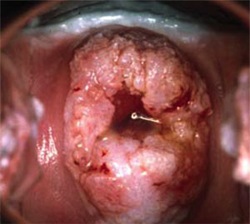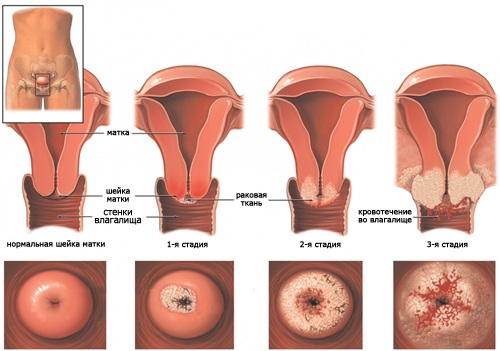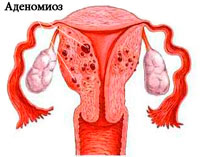
Recently, the participation of the human papillomava (HPV) as a provoking factor in the development of malignant cervical tumors has become a rather sensational topic in the field of sexual tumors. A vaccine has been created, which experts advise to instill girls with the established menstrual cycle, but not yet started to lead an active sex life. This is approximately 12-13 years old. Although some scientists expand deadlines until 20-24 years. That is, until the moment of infecting this virus sexual way.
Unfortunately, the actual value of this vaccine can be evaluated not earlier than in 20-30 years. Grafted girls will enter the age in which cervical cancer is most often started.
And at the moment, the development of theory of a certain role and a simple virus is actively underway Herpes second type (genital). Although supporters and frank opponents divided equally. The first are trying to prove the connection of the virus and tumors of the sexual sphere, others - quite reasonably declare that if we consider the Herpes of the second type, then the wind oil, and cytomegalovirus infection, which are also considered to be considered equally important provocateurs.
Anyway, a woman who was diagnosed «Cervical cancer», Most likely, the recent thing will be interested in the causes of its manifestation.
If you start from the very beginning, the process of development directly cervical cancer has some kind of staging. In many cases, the process is not rapid. Everything can start with extensive or not very Erosion cervix, Then, if there are certain factors (about part of them mentioned earlier) arises dysplasia epithelium of different severity. In other words - a presets that, with proper observation and treatment in carcinoma (cancer), never turn.

The fact is that at the site of erosion begins to form the epithelium, which is unavigated by this site. Still: displays in «Cancer in place» On average takes from 3 to 8 years. This means that the epithelium dysplasia is smooth «Perebed» in cancer, but in that of his form, which is quite successful to treat with good forecasts.
In the absence of treatment for 10-15 years, microenvasive cancer. His main difference from «Cancer in place» - Depth and distribution area. It is much larger. And in the absence of treatment and at this stage, after the same period of time, a common form is developed.
Even with the classification of cervical cancer, it is the degree of its prevalence: starting from the preinval carcinoma («Cancer in place») and ending with the propagation of the tumor on the bladder, the rectum with remote metastases.
How to suspect the possible development of carcinoma?
Readers Our site should know that, like other oncological diseases, cervical cancer may not show itself for a long period of time. Part of women can notice acyclic bloody issues Against the background of normal menstruation or bleeding of various characters in postmenopausal. Some women make complaints about the appearance of white, against the background of which there are contact bleeding after sexual intercourse, gynecological examination, difficulty defecation, physical stress.

At the later stages, with a common cancer, vocational, abundant bleeding may be observed, the difficulty of defecation and urination, driving pain in the sacrism. All this may be complicated by the infection of the urinary system, constipation.
It would seem: at the present stage, in the presence of a large amount of equipment, starting with the ultrasound and ending the nuclear magnetic resonance tomograph, the diagnosis should not represent any difficulty. However, in fact, it turns out exactly the opposite. Start at least from the woman herself. According to statistics, only 29% of women regularly visits the gynecologist, 54% have never been any doctor for the last year. Depressing numbers. Next, not every gynecologist when treatment of erosion cervical Sends material for histological examination to confirm that he treats only erosion. Quite a lot of women for the results of histology do not come. And at the same time, samples of tumor growth fabrics along with the conclusion are stored throughout the entire existence of the laboratory and can be provided on the first requirement, you only need to name the name and approximate date of the study.
So it turns out that if you fold everything together, it will turn out one large factor for the development of common cervical cancer. In addition, smaller, but equally important factors predisposing to the development of cervical cancer:
- early start of sexual life;
- Frequent change of sexual partners;
- a large number of pregnancies regardless of the outcomes (childbirth, abortion);
- The presence of previously transferred sexually transmitted infections.
So, for women from groups of risk of cervical cancer, it is important not just a regular visit to the gynecologist, but also a special examination. The most common is colposcopy, and simply speaking - inspection of the cervix with a great magnification. With colposcopy, various reagents also use, and, staining «Place suspicion», The doctor will be more clearly able to identify further observation and treatment tactics. And during the procedure, there is an opportunity to take both smears and biopsy material for cytological and morphological research.
Another equally important method is a ultrasound study at which you can reveal the degree of distribution of malignant Neof formation, and also navigate in the amount and need for operational intervention. Studies are carried out as in the usual way (transabdominal) when the sensor «water» Through the stomach and transvaginal method, when the sensor is injected into the vagina cavity in order to determine the preinvasive and microenvasive cancers (initial manifestations).
Treatment of cervical cancer

As with most malignant neoplasms, the cervical cancer is treated with a surgical method, radiation, chemotherapy, and also use combined methods.
The volume of surgical intervention directly depends on the stage of cancer. So at 0 stages (preinvasive carcinoma) in women up to 49 years, a cone-shaped amputation of the cervix, T.E. The surgeon minimally affects the genitals, striving to preserve both sexual and reproductive function. But in women over 49 years old, as well as in patients of any age with a mirror of the uterus or relapse (appeared again), the preinstal carcinoma is carried out extirpation of the uterus (its removal) with appendages after the conization. This is due to the fact that the presence of both Moma and the recurrence of the tumor indicates that after only the conization is possible not just a recurrence of cancer, but also its rapid progression.
Undoubtedly, the desire for the woman itself is taken into account. For example, if her relatives had cervical cancer or they died from rapid progression, then a woman explains the risk and consequences of minimal interference. If a pregnancy woman no longer plans, and the risk is high, then even aged 40 years it is possible to radical removal of uterus with appendages.
Readers Our site should know that after such a volume of operation, a woman throughout life will be forced to take hormonal drugs, this is the lack of ovaries.
So, when cancer at stage 1, not only the uterus, appendages, but also the fiber of a small pelvis, the top one third of the vagina, lymphatic glands are removed. After the operation, radiation therapy is carried out.
With 2 and 3 stages of cancer, the usual (remote) radiation therapy is carried out, and intrepathic.
The results of cancer treatment
As with other malignant neoplasms, the effectiveness of the treatment of cervical cancer is estimated at five years of survival. If cancer is diagnosed and cured on the 0th stage, the survival rate is 100%, at the 1st stage - 84-87%, on the 2nd - 66-70%, on the 3rd - 39-42%, and on 4 -You - just 11-13%. An ordinary person (not oncologist) does not say anything about. Therefore, I must say that the numbers are huge. Worth 10 women «forget» For several years to visit the gynecologist for several years if they have the pathology of the cervix, and five years after the treatment of cervical cancer, only 7 will remain.
Summing up: If a woman has a pathology of the cervix, it is necessary to occur at least 4-6 months from the gynecologist and make colposcopy. And when the first detection of adverse signs is first to make an analysis to determine the human papilloma virus and herpes 2 type. With a positive result, the treatment must include both antiviral therapy.
Be careful to your health!









